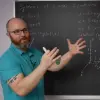

NARROW DISPLAY WARNING
You are most likely using a tablet or mobile device in portrait orientation. This website is best viewed using a typical computer screen with the browser window maximized.
Viewing this website in portrait orientation can cause problems with equations being longer than the screen width (you can scroll to the right), images being poorly sized, and the font size of maths text being much smaller than regular text. If your only option is a tablet or mobile device, your viewing experience will be better if you view this website in landscape orientation. You might need to refresh the page to fix any problems after rotating.
Sometimes the solutions to differential equations were guessed by mathematicians. There is no derivation. For the ODE $ay''+by'+cy=0$ someone guessed a solution $y(x)=e^{rx}$ then tried to figure out what value $r$ needed to be to solve the differential equation. The result of plugging in $e^{rx}$ for $y(x)$ is $e^{rx}(ar^{2}+br+c)=0$. The polynomial $ar^{2}+br+c$ is called the characteristic polynomial and solving for the roots gives the values of $r$ to solve the ODE.
One of three cases for the characteristic polynomial is imaginary roots.
\begin{equation} ay''+by'+cy=0 \qquad y(x)=e^{rx} \end{equation} \begin{equation} e^{rx}(ar^{2}+br+c)=0 \qquad ae^{rx}\big(r-(\lambda+\mu i)\big)\big(r-(\lambda-\mu i)\big)=0 \qquad i = \sqrt{-1} \end{equation}Even though the roots are imaginary, exponentials with imaginary powers are valid solutions.
\begin{equation} y_{1}(x)=e^{(\lambda+\mu i)x} \qquad y_{2}(x)=e^{(\lambda-\mu i)x} \end{equation}The general solution is,
\begin{equation} y(x)=c_{1}e^{(\lambda+\mu i)x}+c_{2}e^{(\lambda-\mu i)x} \end{equation}However, these are not convenient to work with, especially when solving for a real initial condition. An equivalent solution is,
\begin{equation} y(x)=c_{1}e^{\lambda x}\cos(\mu x)+c_{2}e^{\lambda x}\sin(\mu x) \end{equation}Find the general solution to the ODE.
\begin{equation} y'' + y = 0 \end{equation}Find the general solution to the ODE.
\begin{equation} y'' + 4y' + 13y = 0 \end{equation}Solve the initial value problem.
\begin{equation} y'' + 4y = 0 \qquad y(0) = -2 \qquad y'(0)=5 \end{equation}Solve the initial value problem.
\begin{equation} y'' + 2y' + 2y = 0 \qquad y(0) = 1 \qquad y'(0)= 2 \end{equation}Solve the IVP for a mass spring damper system.
\begin{equation} z'' + 4z' + 8z = 0 \qquad z(0) = -3 \qquad z'(0)= 2 \end{equation}The method relies on $e^{i\theta} = \cos(\theta)+i\sin(\theta)$ and combining the constants $c_{1}$ and $c_{2}$ to absorb everything imaginary.
\begin{equation} y(x)=c_{1}e^{(\lambda+\mu i)x}+c_{2}e^{(\lambda-\mu i)x} \end{equation}